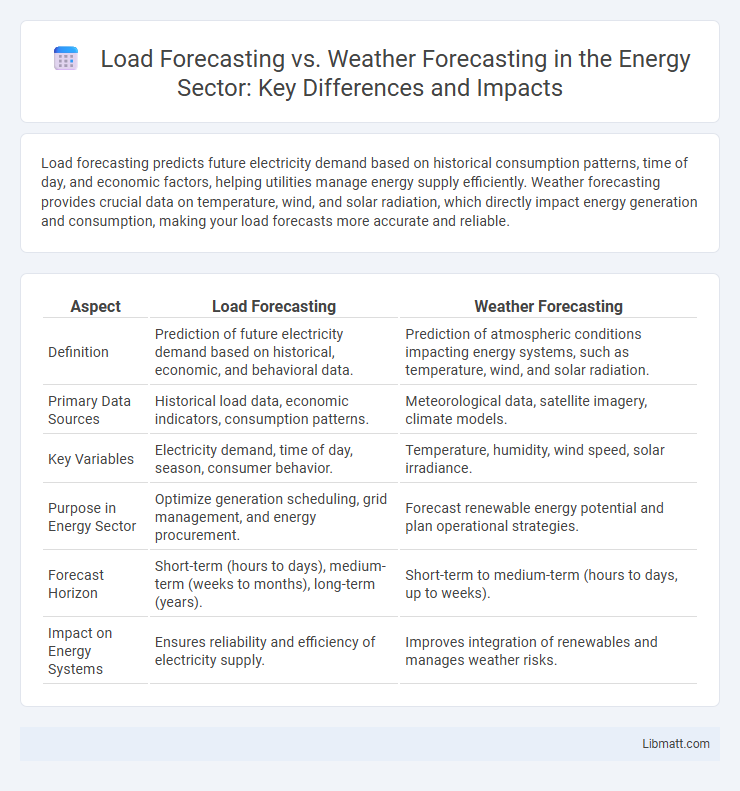Load forecasting predicts future electricity demand based on historical consumption patterns, time of day, and economic factors, helping utilities manage energy supply efficiently. Weather forecasting provides crucial data on temperature, wind, and solar radiation, which directly impact energy generation and consumption, making your load forecasts more accurate and reliable.
Table of Comparison
| Aspect | Load Forecasting | Weather Forecasting |
|---|---|---|
| Definition | Prediction of future electricity demand based on historical, economic, and behavioral data. | Prediction of atmospheric conditions impacting energy systems, such as temperature, wind, and solar radiation. |
| Primary Data Sources | Historical load data, economic indicators, consumption patterns. | Meteorological data, satellite imagery, climate models. |
| Key Variables | Electricity demand, time of day, season, consumer behavior. | Temperature, humidity, wind speed, solar irradiance. |
| Purpose in Energy Sector | Optimize generation scheduling, grid management, and energy procurement. | Forecast renewable energy potential and plan operational strategies. |
| Forecast Horizon | Short-term (hours to days), medium-term (weeks to months), long-term (years). | Short-term to medium-term (hours to days, up to weeks). |
| Impact on Energy Systems | Ensures reliability and efficiency of electricity supply. | Improves integration of renewables and manages weather risks. |
Introduction to Load Forecasting and Weather Forecasting
Load forecasting predicts future electricity demand using historical consumption data, time of day, and economic indicators to optimize energy production and grid management. Weather forecasting provides detailed meteorological data such as temperature, wind speed, and solar radiation crucial for anticipating renewable energy generation and adjusting load forecasts. Accurate integration of weather forecasts enhances load forecasting models, improving the reliability and efficiency of power systems.
Definitions: Load Forecasting vs Weather Forecasting
Load forecasting predicts future electricity demand by analyzing historical consumption patterns, economic indicators, and demographic trends, enabling efficient energy management and grid stability. Weather forecasting uses meteorological data such as temperature, humidity, wind speed, and solar radiation to predict atmospheric conditions that directly impact energy production and consumption. Your energy strategy benefits significantly by integrating both load forecasting and weather forecasting to optimize supply, reduce costs, and enhance reliability.
Importance of Forecasting in the Energy Sector
Accurate load forecasting enables energy providers to predict electricity demand patterns, optimizing grid stability and resource allocation. Weather forecasting directly influences renewable energy generation estimates by anticipating solar radiation, wind speeds, and temperature fluctuations. Together, these forecasts reduce operational costs, enhance energy efficiency, and support reliable integration of renewable sources into the power system.
Key Differences Between Load and Weather Forecasting
Load forecasting predicts electricity demand using historical consumption data, time of day, and economic activity to ensure efficient grid management. Weather forecasting estimates atmospheric conditions such as temperature, humidity, and wind patterns critical for energy production and consumption planning. While load forecasting is primarily driven by consumer behavior and industrial demand, weather forecasting influences renewable energy sources and grid reliability through meteorological analysis.
The Role of Weather Forecasts in Load Prediction
Weather forecasts provide critical inputs such as temperature, humidity, and wind speed, which directly influence energy demand patterns and load variability. Accurate weather predictions enable load forecasting models to anticipate consumption spikes caused by heating and cooling needs, enhancing grid reliability. Integrating meteorological data improves the precision of short-term and long-term load forecasts essential for energy planning and resource allocation.
Data Requirements for Accurate Load and Weather Forecasts
Accurate load forecasting relies on historical energy consumption data, time variables, socioeconomic factors, and real-time system conditions, while weather forecasting depends on extensive atmospheric data such as temperature, humidity, wind speed, and pressure from satellite and ground sensors. Precise synchronization of weather data with load demand patterns enhances predictive models, enabling utilities to optimize energy generation and distribution. Integrating high-resolution weather forecasts with granular load measurements increases forecasting accuracy, reducing operational costs and improving energy reliability.
Methods and Models Used in Load and Weather Forecasting
Load forecasting employs statistical techniques such as time series analysis, regression models, and machine learning algorithms like support vector machines and neural networks to predict future electricity demand based on historical usage, economic indicators, and calendar effects. Weather forecasting relies on numerical weather prediction models that use mathematical representations of atmospheric physics and data assimilation techniques integrating satellite, radar, and ground observations to simulate temperature, humidity, wind speed, and solar radiation. Both forecasting types benefit from hybrid models combining physical insights with data-driven approaches, enhancing accuracy for energy management and operational planning in your utility or energy system.
Challenges in Integrating Weather Forecasts into Load Forecasting
Integrating weather forecasts into load forecasting presents challenges such as variability in weather model accuracy, temporal and spatial resolution mismatches, and the nonlinear influence of weather factors on energy consumption patterns. Inaccurate or low-resolution weather data can lead to errors in predicting peak loads and demand spikes, complicating grid management and energy resource allocation. Advanced machine learning techniques and real-time data assimilation are essential to mitigate uncertainties and improve the reliability of load forecasts influenced by dynamic weather conditions.
Impact of Forecasting Accuracy on Energy Management
Accurate load forecasting enables energy managers to optimize generation schedules, reduce operational costs, and maintain grid stability by predicting future electricity demand with precision. Weather forecasting directly influences load forecasts by providing critical data on temperature, humidity, and solar irradiance, which affect energy consumption patterns and renewable generation output. Improving your forecasting accuracy ensures efficient resource allocation and minimizes risks associated with supply-demand mismatches in energy management.
Future Trends in Load and Weather Forecasting for Energy Systems
Future trends in load forecasting emphasize integrating machine learning algorithms with real-time consumption data to improve accuracy and adapt to evolving consumer behaviors. Weather forecasting advancements leverage high-resolution satellite data and AI-driven models to predict weather patterns that directly impact renewable energy generation. Your energy management can benefit from combining these technologies, optimizing grid reliability and enhancing renewable integration.
Load Forecasting vs Weather Forecasting (Energy Context) Infographic

 libmatt.com
libmatt.com